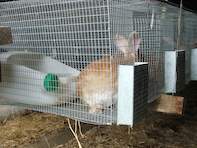Nest Boxes
Nest boxes are a vital piece of equipment and can be made in many ways. Most farmers choose to use wooden boxes, either placed in the cage or clipped onto the outside of the cage with a hole in the cage for the doe to get in and out of.

Alternatively, a 25-litre or 5-litre plastic water can can also be cut to create cosy, easily cleaned boxes. Moulded plastic clip on boxes are available, and although expensive, are very easy to manage. A very cost effective nest box can be made by cutting a hole into the front on a cardboard box.
Care must be taken to ensure that the box is kept dry and will only be used once. Once the litter is weaned, tear up the cardboard (what is left of it after mother rabbit has had her chew) and can be added to the compost heap to break down into compost.
Transport boxes
Rabbits need to be moved around and it is good to use a transport box to do this. It can be a small wire cage with handles, or made from wood, also with carrying handles. If a box is required to move many animals, it’s best to have four or five compartments in the crates.
When animals travel in a vehicle they need to be in secure, well-ventilated boxes or crates that protects them for the journey. Care must be taken to not overcrowd the rabbits and if they are taken on a long journey make sure that they have carrots or apples in the crates, which supply feed and liquid. The longer the journey the fewer animals in a crate. Most journeys are between 1 – 6 hours.